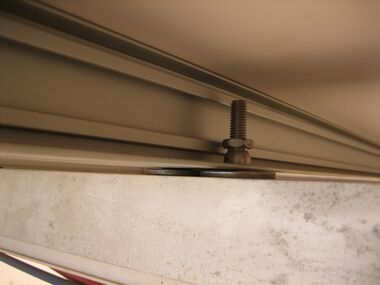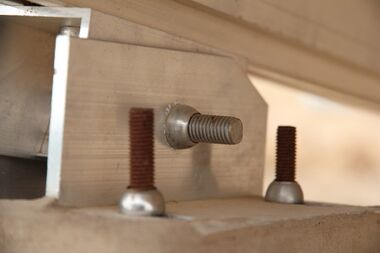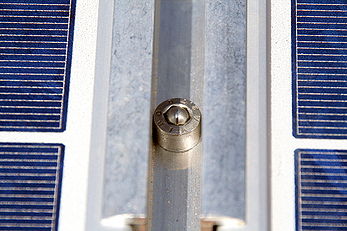Knowledge fuels change
For over a decade, Energypedia has shared free, reliable energy expertise with the world.
We’re now facing a serious funding gap.
Help keep this platform alive — your donation, big or small, truly matters!
Thank you for your support
Difference between revisions of "Tools to Prevent Theft of Panels"
***** (***** | *****) |
***** (***** | *****) m |
||
| (25 intermediate revisions by 4 users not shown) | |||
| Line 1: | Line 1: | ||
| − | + | =Overview= | |
| − | + | {{#widget:YouTube|id=kxoUsXtUslY|height=400|width=600}} | |
| − | + | Awareness and popularity of solar systems has risen and so has the number of thefts of solar panels. Since the price of the panel amounts up to 50% of the investment cost of a PV system, it is most lucrative to steal this part of the installation. In Senegal, for instance, is is supposed that up to 15% of the solar panels are stolen. | |
| − | + | Several solutions exist to this problem, which differ in feasibility, practicability, price and technical knowledge. | |
| − | + | A major concern should be the local availability of the technology. | |
| − | + | Eventually, each project should choose a mixture of several of the alternatives mentioned below, tailored to the circumstances of the project. | |
| − | + | =Theft-proof Screws= | |
| − | + | <u>These screws come in several types:</u> most common are screws (or nuts) that break when a certain torque is applied and hex key screws into which a small item (such as a ball or star) is hammered after tightening. | |
| − | + | After fastening, these screws cannot be unmounted unless special tools are available. However, only proper usage assures effective protection. The product combination and the way of fastening the screws should thus be tested (best before purchase). | |
| − | <br> | + | <br /> |
| − | + | {| class="FCK__ShowTableBorders" style="width: 100%" cellspacing="1" cellpadding="1" border="0" align="center" | |
| + | |- | ||
| + | | style="text-align: center; vertical-align: middle" |[[File:Theft-proof bolt before breaking.JPG|thumb|380x380px|Theft-proof nut and bolt (in this example, the nut breaks)|alt=|left]] | ||
| + | | style="text-align: center; vertical-align: middle" |[[File:Theft-proof bolt after breaking.JPG|thumb|380x380px|Nut after breaking|alt=|left]] | ||
| + | |- | ||
| + | | style="text-align: center; vertical-align: middle" |[[File:Theft-proof hex key screw with insert.JPG|thumb|347px|Theft-proof hex key screw with ball insert|alt=|left]] | ||
| + | | style="text-align: center; vertical-align: middle" | | ||
| + | |} | ||
| − | + | =Flocks of Goats= | |
| − | + | This technique has already been used by the ancient Romans, since geese show the habit to become noisy when they are alarmed. May not be a good idea for panels mounted close to the ground since animals can cause damage to panels, support structure and wiring and / or may pollute the panels. | |
| − | <br> | + | <br /> |
| − | + | =Immobilize the Panels= | |
| − | + | A company from the US offers panel-embedded smart electronic chips, which lock the panel digitally in the moment the panel is being stolen. The technique starts working automatically, if the power optimisers receive no activation signal from the inverter. This immobilization of the panels ensures that no power is produced anymore, which makes a reuse of the panels impossible. | |
| − | + | Even if the thief does not only steal the panel but also the inverter, the installation becomes unusable, since the solar inverter communicates with the monitoring server via a built-in communication hardware. If the inverter does not receive activation signals from the server for a certain defined period, the inverter gets immobilized. | |
| − | + | =Glueing, Welding or Sealing the Panels onto the Available Roof Space= | |
| − | + | These are not very suitable solutions, since maintenance and replacement become more difficult or even impossible. Moreover, proper air flow may be hindered, which makes panels work more poorly. Furthermore, in a warranty case conditions can probably not be met due to changes at the installation. | |
| − | + | Some persons have painted the back of their panels in a very bright colour in order to be able to identify their panel in case of theft. | |
| − | <br> | + | <br /> |
| − | + | =Design a Rack= | |
| − | This | + | This means locking the panels into one large block in order to prevent thefts. In fact, this creates problems for maintenance, but also for thieves, since the weight of locked panels is enormous. |
| − | <br> | + | <br /> |
| − | + | =Use an Alarm via cable connection= | |
| − | The | + | This solutions connects all panels of the installation via cable. The ends of this cable are connected to a control circuit, which picks up every manipulation in the cable. This control circuit can be connected with a visual and/or sound alarm, which is triggered if the cables are removed. Obviously, the horn has to be installed in a safe place such that its own cables cannot be cut before. |
| − | <br> | + | <br /> |
| − | + | =Keep a Manual Vigil= | |
| − | Using special fastening means like round-headed screws is a simple and cheap method to prevent thefts. Functioning like car keys, customers get a secured access to an exclusive security fastener, which allows only them to open the screws. | + | The easiest and probably cheapest solution is a night watchman, for example on a rotational basis among the neighbours. |
| + | |||
| + | =Security Fasteners= | ||
| + | |||
| + | Using special fastening means like round-headed screws is a simple and cheap method to prevent thefts. Functioning like car keys, customers get a secured access to an exclusive security fastener, which allows only them to open the screws. | ||
| + | |||
| + | = Mark the Panels = | ||
| + | Use a permanent marker to mark the side of the modules with the community's name and other information such as location and date to prevent reselling of the module. The modules should only be marked on the side and one should be careful not to scratch the solar cells. <ref>https://thesolarhub.org/wp-content/uploads/2021/07/Technical-Brief-on-Security-of-Solar-Modules-1.pdf</ref><br /> | ||
| + | |||
| + | = Add lighting = | ||
| + | Add a solar light around the panel to illuminate the area at night and deter intruders from breaking in.<ref>https://thesolarhub.org/wp-content/uploads/2021/07/Technical-Brief-on-Security-of-Solar-Modules-1.pdf</ref> | ||
| + | |||
| + | =Further Information = | ||
| + | |||
| + | *[https://thesolarhub.org/resources/security-of-solar-panels/ Preventing theft of solar panels] | ||
| + | *[[Portal:Solar|Solar Portal on energypedia]] | ||
| + | *[[Solar Home Systems (SHS)|Solar Home Systems]] | ||
| + | *[[Solar Cells and Modules]]<br /> | ||
| + | =References = | ||
| + | |||
| + | <references /> | ||
[[Category:Solar]] | [[Category:Solar]] | ||
Latest revision as of 11:46, 29 June 2022
Overview
Awareness and popularity of solar systems has risen and so has the number of thefts of solar panels. Since the price of the panel amounts up to 50% of the investment cost of a PV system, it is most lucrative to steal this part of the installation. In Senegal, for instance, is is supposed that up to 15% of the solar panels are stolen.
Several solutions exist to this problem, which differ in feasibility, practicability, price and technical knowledge.
A major concern should be the local availability of the technology.
Eventually, each project should choose a mixture of several of the alternatives mentioned below, tailored to the circumstances of the project.
Theft-proof Screws
These screws come in several types: most common are screws (or nuts) that break when a certain torque is applied and hex key screws into which a small item (such as a ball or star) is hammered after tightening.
After fastening, these screws cannot be unmounted unless special tools are available. However, only proper usage assures effective protection. The product combination and the way of fastening the screws should thus be tested (best before purchase).
Flocks of Goats
This technique has already been used by the ancient Romans, since geese show the habit to become noisy when they are alarmed. May not be a good idea for panels mounted close to the ground since animals can cause damage to panels, support structure and wiring and / or may pollute the panels.
Immobilize the Panels
A company from the US offers panel-embedded smart electronic chips, which lock the panel digitally in the moment the panel is being stolen. The technique starts working automatically, if the power optimisers receive no activation signal from the inverter. This immobilization of the panels ensures that no power is produced anymore, which makes a reuse of the panels impossible.
Even if the thief does not only steal the panel but also the inverter, the installation becomes unusable, since the solar inverter communicates with the monitoring server via a built-in communication hardware. If the inverter does not receive activation signals from the server for a certain defined period, the inverter gets immobilized.
Glueing, Welding or Sealing the Panels onto the Available Roof Space
These are not very suitable solutions, since maintenance and replacement become more difficult or even impossible. Moreover, proper air flow may be hindered, which makes panels work more poorly. Furthermore, in a warranty case conditions can probably not be met due to changes at the installation.
Some persons have painted the back of their panels in a very bright colour in order to be able to identify their panel in case of theft.
Design a Rack
This means locking the panels into one large block in order to prevent thefts. In fact, this creates problems for maintenance, but also for thieves, since the weight of locked panels is enormous.
Use an Alarm via cable connection
This solutions connects all panels of the installation via cable. The ends of this cable are connected to a control circuit, which picks up every manipulation in the cable. This control circuit can be connected with a visual and/or sound alarm, which is triggered if the cables are removed. Obviously, the horn has to be installed in a safe place such that its own cables cannot be cut before.
Keep a Manual Vigil
The easiest and probably cheapest solution is a night watchman, for example on a rotational basis among the neighbours.
Security Fasteners
Using special fastening means like round-headed screws is a simple and cheap method to prevent thefts. Functioning like car keys, customers get a secured access to an exclusive security fastener, which allows only them to open the screws.
Mark the Panels
Use a permanent marker to mark the side of the modules with the community's name and other information such as location and date to prevent reselling of the module. The modules should only be marked on the side and one should be careful not to scratch the solar cells. [1]
Add lighting
Add a solar light around the panel to illuminate the area at night and deter intruders from breaking in.[2]
Further Information
- Preventing theft of solar panels
- Solar Portal on energypedia
- Solar Home Systems
- Solar Cells and Modules






















